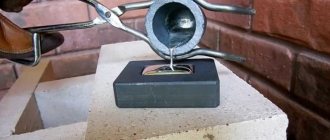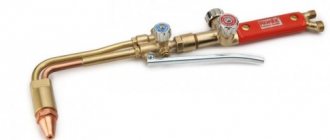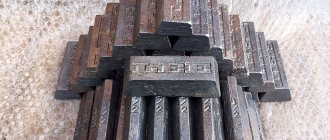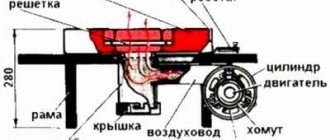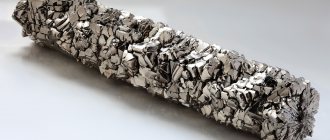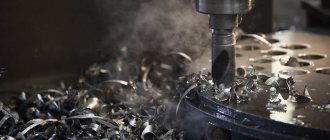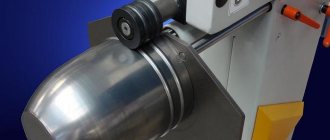| Lead | |
| Atomic number | 82 |
| Appearance of a simple substance | |
| Properties of the atom | |
| Atomic mass (molar mass) | 207.2 a. e.m. (/mol) |
| Atomic radius | 175 |
| Ionization energy (first electron) | 715.2 (7.41) kJ/mol () |
| Electronic configuration | [Xe] 4f14 5d10 6s2 6p2 |
| Chemical properties | |
| Covalent radius | 147 |
| Ion radius | (+4e) 84 (+2e) 120 |
| Electronegativity (Pauling) | 1,8 |
| Electrode potential | Pb←Pb2+ -0.126 V Pb←Pb4+ 0.80 V |
| Oxidation states | 4, 2 |
| Thermodynamic properties of a simple substance | |
| Density | 11,3415 /³ |
| Molar heat capacity | 26.65[1]/(mol) |
| Thermal conductivity | 35,3 /(·) |
| Melting temperature | 600,65 |
| Heat of Melting | 4.77 kJ/mol |
| Boiling temperature | 2 013 |
| Heat of vaporization | 177.8 kJ/mol |
| Molar volume | 18.3 ³/mol |
| Crystal lattice of a simple substance | |
| Lattice structure | cubic face-centered |
| Lattice parameters | 4,950 |
| c/a ratio | n/a |
| Debye temperature | 88,00 |
| Pb | 82 |
| 207,2 | |
| [Xe]4f145d106s26p2 | |
| Lead | |
Lead
- an element of the main subgroup of the fourth group, the sixth period of the periodic system of chemical elements of D.I. Mendeleev, with atomic number 82. Denoted by the symbol Pb (Latin: Plumbum). The simple substance lead (CAS number: 7439-92-1) is a malleable, relatively fusible gray metal.
The origin of the word "lead" is unclear. In most Slavic languages (Bulgarian, Serbo-Croatian, Czech, Polish) lead is called tin. A word with the same meaning, but similar in pronunciation to “lead”, is found only in the languages of the Baltic group: švinas (Lithuanian), svins (Latvian). The Latin plumbum (also of unclear origin) gave the English word plumber - plumber (once pipes were caulked with soft lead), and the name of the Venetian prison with a lead roof - Piomba, from which, according to some sources, Casanova managed to escape. Known since ancient times. Products made from this metal (coins, medallions) were used in Ancient Egypt, lead water pipes - in Ancient Rome. Lead is referred to as a specific metal in the Old Testament. Lead smelting was the first metallurgical process known to man. Until 1990, large quantities of lead were used (together with antimony and tin) to cast typographical fonts, and also in the form of tetraethyl lead to increase the octane number of motor fuels.
Chemical properties of lead
Electronic formula: KLMN5s25p65d106s26p2, according to which it has oxidation states +2 and +4. Lead is not very reactive chemically. A metallic section of lead shows a metallic luster, which gradually disappears due to the formation of a thin film of PbO.
With oxygen it forms a number of compounds Pb2O, PbO, PbO2, Pb2O3, Pb3O4. Without oxygen, water at room temperature does not react with lead, but at high temperatures lead oxide and hydrogen are produced by the interaction of lead and hot water vapor.
The oxides PbO and PbO2 correspond to the amphoteric hydroxides Pb(OH)2 and Pb(OH)4.
The reaction of Mg2Pb and dilute HCl produces a small amount of PbH4. PbH4 is an odorless gaseous substance that very easily decomposes into lead and hydrogen. At high temperatures, halogens form compounds of the type PbX2 with lead (X is the corresponding halogen). All these compounds are slightly soluble in water. Halides of the PbX4 type can also be obtained. Lead does not react directly with nitrogen. Lead azide Pb(N3)2 is obtained indirectly: by reacting solutions of Pb(II) salts and NaN3 salt. Lead sulfides can be obtained by heating sulfur with lead, PbS sulfide is formed. Sulfide is also obtained by passing hydrogen sulfide into solutions of Pb(II) salts. In the voltage series, Pb is to the left of hydrogen, but lead does not displace hydrogen from dilute HCl and H2SO4, due to the overvoltage of H2 on Pb, and films of poorly soluble PbCl2 chloride and PbSO4 sulfate are formed on the metal surface, protecting the metal from further action of acids. When heated, concentrated acids such as H2SO4 and HCl act on Pb and form with it soluble complex compounds of the composition Pb(HSO4)2 and H2[PbCl4]. Nitric acid, as well as some organic acids (for example, citric acid) dissolve lead to produce Pb(II) salts. According to their solubility in water, lead salts are divided into insoluble (for example, sulfate, carbonate, chromate, phosphate, molybdate and sulfide), slightly soluble (for example, chloride and fluoride) and soluble (for example, lead acetate, nitrate and chlorate). Pb(IV) salts can be obtained by electrolysis of solutions of Pb(II) salts strongly acidified with sulfuric acid. Pb(IV) salts add negative ions to form complex anions, for example, plumbates (PbO3)2- and (PbO4)4-, chloroplumbates (PbCl6)2-, hydroxoplumbates [Pb(OH)6]2- and others. Concentrated solutions of caustic alkalis react with Pb when heated, releasing hydrogen and hydroxoplumbites of the X2[Pb(OH)4] type. Eion (Me=>Me++e)=7.42 eV.
Lead Poisoning Symptoms
Lead poisoning can be difficult to detect initially—even healthy people can have high levels of lead in their blood. Signs and symptoms usually do not appear until dangerous amounts have accumulated.
Signs and symptoms of poisoning may include:
- High blood pressure.
- Joint and muscle pain.
- Problems with memory or concentration.
- Headache.
- Abdominal pain.
- Mood disorders.
- Low sperm count and abnormal sperm.
- Miscarriage, stillbirth or premature birth in pregnant women.
Employers have a responsibility to protect workers from exposure to inorganic lead. The employer must also initiate specific compliance actions, including blood lead testing for exposed employees.
Main lead compounds
Lead oxides
Lead oxides are predominantly basic or amphoteric in nature. Many of them are painted red, yellow, black, and brown. In the photograph at the beginning of the article, on the surface of the lead casting, tarnish colors are visible in its center - this is a thin film of lead oxides formed due to the oxidation of hot metal in air.
Lead halides
Lead chalcogenides
Lead chalcogenides—lead sulfide, lead selenide, and lead telluride—are black crystals that are narrow-gap semiconductors.
Lead salts
Lead sulfate Lead nitrate Lead acetate
- Lead sugar is a very toxic substance. Lead acetate, or lead sugar, Pb(CH3COO)2·3H2O exists in the form of colorless crystals or white powder, which slowly erodes with the loss of water of hydration. The compound is highly soluble in water. It has an astringent effect, but since it contains poisonous lead ions, it is used externally in veterinary medicine. Acetate is also used in analytical chemistry, dyeing, calico printing, as a silk filler, and for the production of other lead compounds. Basic lead acetate Pb(CH3COO)2·Pb(OH)2, a less water-soluble white powder, is used to decolorize organic solutions and purify sugar solutions before analysis.
Melting temperature
The normal melting point of lead is 327.46 C, which is reached relatively quickly. The second indicator for the melting process is the pouring temperature - 400-450 degrees, in this range the metal acquires the necessary viscosity and consistency for filling molds.
When working with molten metal, you must wear a respirator.
Lead Applications
Lead in the national economy
Lead nitrate
used for the production of powerful mixed explosives.
Lead azide is used as the most widely used detonator (initiating explosive). Lead perchlorate is used to prepare a heavy liquid (density 2.6 g/cm³) used in flotation beneficiation of ores, and it is sometimes used in high-power mixed explosives as an oxidizing agent. Lead fluoride alone, as well as together with bismuth, copper, and silver fluoride, is used as a cathode material in chemical current sources. Lead bismuthate, lead sulfide PbS, lead iodide are used as cathode material in lithium batteries. Lead chloride PbCl2 as a cathode material in backup current sources. Lead telluride PbTe is widely used as a thermoelectric material (thermo-emf with 350 μV/K), the most widely used material in the production of thermoelectric generators and thermoelectric refrigerators. Lead dioxide PbO2 is widely used not only in lead batteries, but also on its basis many reserve chemical current sources are produced, for example, lead-chlorine cell, lead-fluoride cell, etc. Lead white
, basic carbonate Pb(OH)2•PbCO3 , a dense white powder, is obtained from lead in air under the influence of carbon dioxide and acetic acid. The use of white lead as a coloring pigment is no longer as common as it once was due to its decomposition by hydrogen sulfide H2S. Lead white is also used for the production of putty, in the technology of cement and lead carbonate paper. Lead arsenate and arsenite are used in insecticide technology to kill agricultural pests (gypsy moth and cotton boll weevil). Lead borate Pb(BO2)2·H2O, an insoluble white powder, is used to dry paintings and varnishes, and, along with other metals, as coatings on glass and porcelain. Lead chloride PbCl2, a white crystalline powder, is soluble in hot water, solutions of other chlorides and especially ammonium chloride NH4Cl. It is used to prepare ointments for treating tumors. Lead chromate PbCrO4 is known as chrome yellow dye, and is an important pigment for making paints, for dyeing porcelain and fabrics. In industry, chromate is used mainly in the production of yellow pigments. Lead nitrate Pb(NO3)2 is a white crystalline substance, highly soluble in water. This is a binder of limited use. In industry, it is used in matchmaking, textile dyeing and printing, antler dyeing and engraving. Lead sulfate Pb(SO4)2, a water-insoluble white powder, is used as a pigment in batteries, lithography, and printed fabric technology. Lead sulfide PbS, a black, water-insoluble powder, is used in firing pottery and to detect lead ions. Since lead absorbs γ radiation well, it is used for radiation protection in X-ray facilities and in nuclear reactors. In addition, lead is considered as a coolant in projects of advanced fast neutron nuclear reactors. Lead alloys are widely used. Pewter (tin-lead alloy), containing 85-90% Sn and 15-10% Pb, is moldable, inexpensive and used in the manufacture of household utensils. Solder containing 67% Pb and 33% Sn is used in electrical engineering. Alloys of lead and antimony are used in the production of bullets and typographic fonts, and alloys of lead, antimony and tin are used for figured casting and bearings. Lead-antimony alloys are commonly used for cable sheaths and electric battery plates. Lead compounds are used in the production of dyes, paints, insecticides, glass products and as an additive to gasoline in the form of tetraethyl lead (C2H5)4Pb (moderately volatile liquid, vapors in small concentrations have a sweetish fruity odor, in large concentrations they have an unpleasant odor; Tm = 130 °C, boiling point = 80 °C/13 mm Hg; density 1.650 g/cm³; nD2v = 1.5198; not soluble in water, miscible with organic solvents; highly toxic, easily penetrates skin; maximum permissible concentration = 0.005 mg/m³; LD50 = 12.7 mg/kg (rat, oral)) to increase octane number.
Lead in medicine
Economic indicators
Prices for lead in ingots (grade C1) in 2006 averaged 1.3-1.5 dollars/kg.
Countries, largest consumers of lead in 2004, in thousand tons (according to ILZSG):
| China | 1770 |
| EU | 1553 |
| USA | 1273 |
| Korea | 286 |
Security measures
When working with molten metal, it is imperative to protect the skin from thermal burns. During work, be sure to wear fireproof gloves and cloth or linen clothing that can withstand the ingress of molten substances.
In addition, it is necessary to wear a respirator or gauze bandage to protect the respiratory system - lead is a toxic substance.
So, by following these tips and using the information about the melting process, it won't be much of a problem to cast a fishing sinker or melt down the remains of an old battery into one ingot.
Historical information
Lead has been used for thousands of years because it is widespread and easy to mine and process. It is very malleable and melts easily. Lead smelting was the first metallurgical process known to man. Lead beads dating back to 6400 BC. BC, were found in the Çatalhöyük culture. The oldest object made of lead is often considered to be a figurine of a standing woman in a long skirt from the First Dynasty of Egypt, dating back to 3100-2900. BC BC, stored in the British Museum (stock number EA 32138). It was found in the Temple of Osiris at Abydos and brought from Egypt in 1899. In Ancient Egypt, lead medallions were used. In the Early Bronze Age, lead was used along with antimony and arsenic. Lead is referred to as a specific metal in the Old Testament.
Lead pipes of an ancient Roman water supply with inscriptions
The largest producer of lead in the pre-industrial era was Ancient Rome, with an annual production of 80,000 tons. Roman mining of lead took place in Central Europe, Roman Britain, the Balkans, Greece, Asia Minor and Spain. The Romans widely used lead in the production of pipes for water supply systems, and lead pipes often bore the inscriptions of Roman emperors. True, even Pliny and Vitruvius believed that this was not good for public health.
Papal bull of 1637 with lead seal
After the fall of the Roman Empire in the 5th century. n. e. Lead use in Europe fell and remained low for about 600 years. Then lead began to be mined in eastern Germany. Lead sugar has been added to wine since Roman times to improve its taste; this became widespread and continued even after the ban by a papal bull in 1498. This use of lead in the Middle Ages led to epidemics of lead colic. In Ancient Rus', lead was used to cover the roofs of churches, and was also widely used as a material for hanging seals on letters. Later, in 1633, a water supply system with lead pipes was built in the Kremlin, through which water came from the Vodovzvodnaya Tower; it existed until 1737.
In alchemy, lead was associated with the planet Saturn and was represented by its symbol ♄. In ancient times, tin, lead and antimony were often not distinguished from each other, considering them to be different types of the same metal, although Pliny the Elder distinguished between tin and lead, calling tin “plumbum album” and lead “plumbum nigrum”.
The Industrial Revolution led to a new increase in the demand for lead. By the beginning of the 1840s. annual production of refined lead exceeded 100,000 tons for the first time and grew to over 250,000 tons over the next 20 years. Until the last decades of the 19th century, lead mining was primarily carried out by three countries: Britain, Germany and Spain. By the beginning of the 20th century, lead mining in Europe had become less than in the rest of the world, thanks to increased production in the United States, Canada, Mexico and Australia. Until 1990, large quantities of lead were used (together with antimony and tin) to cast typographical fonts, and also in the form of tetraethyl lead to increase the octane number of motor fuels.
Methods for getting rid of oxide
During interaction with air, an ionic bond is formed between metal atoms and the environment. Oxygen gives up two electrons. An oxidizing layer quickly appears on the surface. Such an oxide film can prevent further exposure to a hostile environment. The film also becomes a barrier during the transmission of electricity.
An oxide film on a product made from lead appears after a short period of time. Mechanical cleaning is a rather labor-intensive and useless task. Immediately after successful removal of the layer, a field is formed, and the bare atoms come into contact with new air atoms. You can create protection for an item by using sunflower oil. An option with graphite lubricant and varnish is also relevant.
Sunflower oil is great for household use. The oil is poured into a bowl, after which the required lead product is placed in the liquid. With proper exposure (about 5 minutes), you need to pull the product out of the oil and let it dry on prepared napkins.
In production conditions, graphite lubricant is used to reduce the spread of oxide inclusions on the surface of parts. Lubricant is not rare or expensive, but in everyday life it is rarely available. This product is sold in car dealerships and hardware stores. If treated properly, the lead surface will exhibit shine for a long time.
Graphite Lead Grease
If the oxide film has already successfully coated the surface, there are ways to remove it. For this, a concentrated acid solution is used. Such actions require special training, including the availability of chemical glass equipment. Regular table jars or bowls will not work. Reactive ingredients can cause harm to humans and leave burns on the body.
The use of protective glasses and a mask is encouraged.
The workpiece is immersed in an acid solution. It is necessary to wait until the oxide film is destroyed. After successful lifting from the solution, the surface is treated with oil or varnish to protect it.
Definition
The term means a physical quantity that is numerically equated to the amount of heat that must be transferred to a body weighing 1 kg in order for the temperature indicator to change by 1 Kelvin. The concept is denoted by the symbol c and is calculated using the formula c = Q / (m ΔT) , where:
- Q – heat obtained during the reaction;
- m – mass of the heated body;
- ΔT is the difference between the starting and final temperatures.
It is necessary to take into account not only the temperature regime, but also other factors influencing the result. This can be volume, pressure and other features. The conditions for changing thermodynamic and temperature characteristics are also taken into account.
Home and industrial methods
To isolate and smelt pure lead, galena is most often used as a smelting base. The concentrate is enriched to 40-70% by flotation. Next, several melting methods are used:
- Electrothermal melting.
- Vanyukov method of thermal melting (melting in a liquid bath).
- Melting in a shaft (water jacket) furnace.
After chemical treatment, impurities of other elements are removed, resulting in lead purity reaching more than 99%.
The main producers are: EU countries (melting 2200 kilotons), USA (1400), China (1200), Russian Federation (1100). Also, widespread production of smelting components is located in the South Korean Republic, Ukraine and Kazakhstan.
Preparing the melt
To start melting at home, select a container with a heat-resistant handle that can withstand high temperatures. An old kitchen kettle or similar household utensil is suitable for this function. At home, you can use cast iron cookware; if there are no other options, you can use canning containers, using pliers due to the high temperature of the operation. The future location where the tool will grip the can should be provided in advance. For convenience, you can make a hole in the tin can near the rim. This will make it possible to accurately pour metal at a high temperature in the right place, without drips of molten mass from the outside of the container.
The processed material is crushed and the mass is removed from excess inclusions by any available means. The better the metal is crushed, the faster it will melt. The container must be securely installed above the fire source and heated to eliminate moisture and foreign impurities.
